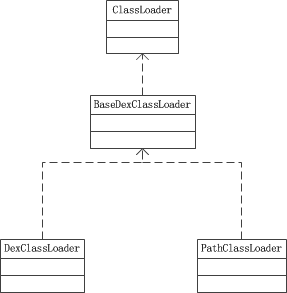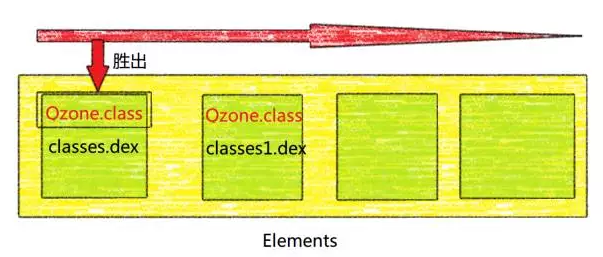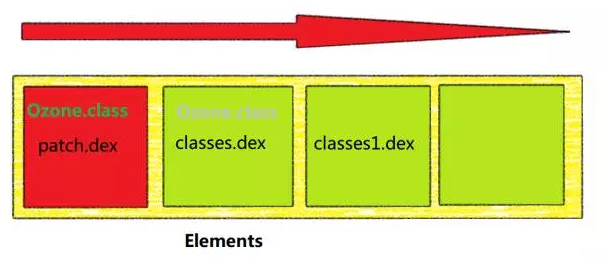一、参考
博文:安卓App热补丁动态修复技术介绍——by QQ空间终端开发团队
博文:Android dex分包方案——by 猫的午后
开源项目:https://github.com/jasonross/Nuwa
开源项目:https://github.com/dodola/HotFix
http://blog.csdn.net/u010386612/article/details/50885320
感谢以上几位大神分享的技术知识!
关于热补丁技术,以上文章已经做了很详细的描述。但是细节上的东西都一带而过,这里会做出更为详细的说明,更适合初学者学习这门技术。
二、Dex分包方案的由来
2.1 Dalvik限制
众所周知,当apk解压后里面是只有一个classes.dex文件的,而这个dex文件里面就包含了我们项目的所有.class文件。
但是当一个app功能越来越复杂,可能会出现两个问题:
- 编译失败,因为一个dvm中存储方法id用的是short类型,导致dex中方法不能超过65536个
- 你的apk在android 2.3之前的机器无法安装,因为dex文件过大(用来执行dexopt的内存只分配了5M)
2.2 解决方案
针对上述两个问题,有人研究出了dex分包方案。
原理就是将编译好的class文件拆分打包成两个dex,绕过dex方法数量的限制以及安装时的检查,在运行时再动态加载第二个dex文件中。
除了第一个dex文件(即正常apk包唯一包含的Dex文件),其它dex文件都以资源的方式放在安装包中,并在Application的onCreate回调中被注入到系统的ClassLoader。因此,对于那些在注入之前已经引用到的类(以及它们所在的jar),必须放入第一个Dex文件中。
三、Dex分包的原理——ClassLoader
接下来我们就来看看,如何将第二个dex文件注入到系统中。
3.1 ClassLoader体系
我们都知道,Java执行程序的时候是需要先将字节码加载到jvm之后才会被执行的,而这个过程就是使用到了ClassLoader类加载器。Android也是如此
以下是DVM的ClassLoader体系
查看官方文档可以知道以下两点:
1.android系统是通过PathClassLoader加载系统类和已安装的应用的。
Android uses this class for its system class loader and for its application class loader(s).
2.而DexClassPath则可以从一个jar包或者未安装的apk中加载dex
A class loader that loads classes from .jar and .apk files containing a classes.dex entry. This can be used to execute code not installed as part of an application.
从这里就可以看出,动态加载dex的时候我们应该使用DexClassLoader
3.2 ClassLoader源码分析
源码可以到这个网站查阅:http://androidxref.com/
DexClassLoader和PathClassLoader都只重写了BaseDexClassLoader的构造而已,而具体的加载逻辑则在BaseDexClassLoader中。
这部分源码都很简单,请务必看懂
BaseDexClassLoader部分源码:
- 1
- 2
- 3
- 4
- 5
- 6
- 7
- 8
- 9
- 10
- 11
- 12
- 13
- 14
- 15
- 16
- 17
- 18
- 19
- 20
- 21
- 22
- 23
- 24
- 25
- 26
- 27
- 28
- 29
- 30
- 31
- 32
- 33
- 34
- 35
- 36
- 1
- 2
- 3
- 4
- 5
- 6
- 7
- 8
- 9
- 10
- 11
- 12
- 13
- 14
- 15
- 16
- 17
- 18
- 19
- 20
- 21
- 22
- 23
- 24
- 25
- 26
- 27
- 28
- 29
- 30
- 31
- 32
- 33
- 34
- 35
- 36
从源码得知,当我们需要加载一个class时,实际是从pathList中去找的,而pathList则是DexPathList的一个实体。
DexPathList部分源码:
- 1
- 2
- 3
- 4
- 5
- 6
- 7
- 8
- 9
- 10
- 11
- 12
- 13
- 14
- 15
- 16
- 17
- 18
- 19
- 20
- 21
- 22
- 23
- 24
- 25
- 26
- 27
- 28
- 29
- 30
- 31
- 32
- 33
- 34
- 35
- 36
- 37
- 38
- 39
- 40
- 41
- 42
- 43
- 44
- 45
- 1
- 2
- 3
- 4
- 5
- 6
- 7
- 8
- 9
- 10
- 11
- 12
- 13
- 14
- 15
- 16
- 17
- 18
- 19
- 20
- 21
- 22
- 23
- 24
- 25
- 26
- 27
- 28
- 29
- 30
- 31
- 32
- 33
- 34
- 35
- 36
- 37
- 38
- 39
- 40
- 41
- 42
- 43
- 44
- 45
从这段源码可以看出,dexElements是用来保存dex的数组,而每个dex文件其实就是DexFile对象。遍历dexElements,然后通过DexFile去加载class文件,加载成功就返回,否则返回null
通常情况下,dexElements数组中只会有一个元素,就是apk安装包中的classes.dex
而我们则可以通过反射,强行的将一个外部的dex文件添加到此dexElements中,这就是dex的分包原理了。
这也是热补丁修复技术的原理。
四、热补丁修复技术的原理
上面的源码,我们注意到一点,如果两个dex中存在相同的class文件会怎样?
先从第一个dex中找,找到了直接返回,遍历结束。而第二个dex中的class永远不会被加载进来。
简而言之,两个dex中存在相同class的情况下,dex1的class会覆盖dex2的class。
盗一下QQ空间的图,如图:classes1.dex中的Qzone.class并不会被加载
而热补丁技术则利用了这一特性,当一个app出现bug的时候,我们就可以将出现那个bug的类修复后,重新编译打包成dex,插入到dexElements的前面,那么出现bug的类就会被覆盖,app正常运行,这就是热修复的原理了。
五、本章结束
这章为大家介绍了热补丁技术的原理,但是大家可能并不会实际操作。
1. 怎么通过反射将dex插入到elements
2. 怎么讲修复后的类打包成dex
这将是下一篇博客的内容,感谢阅读。
























 1466
1466











 被折叠的 条评论
为什么被折叠?
被折叠的 条评论
为什么被折叠?








